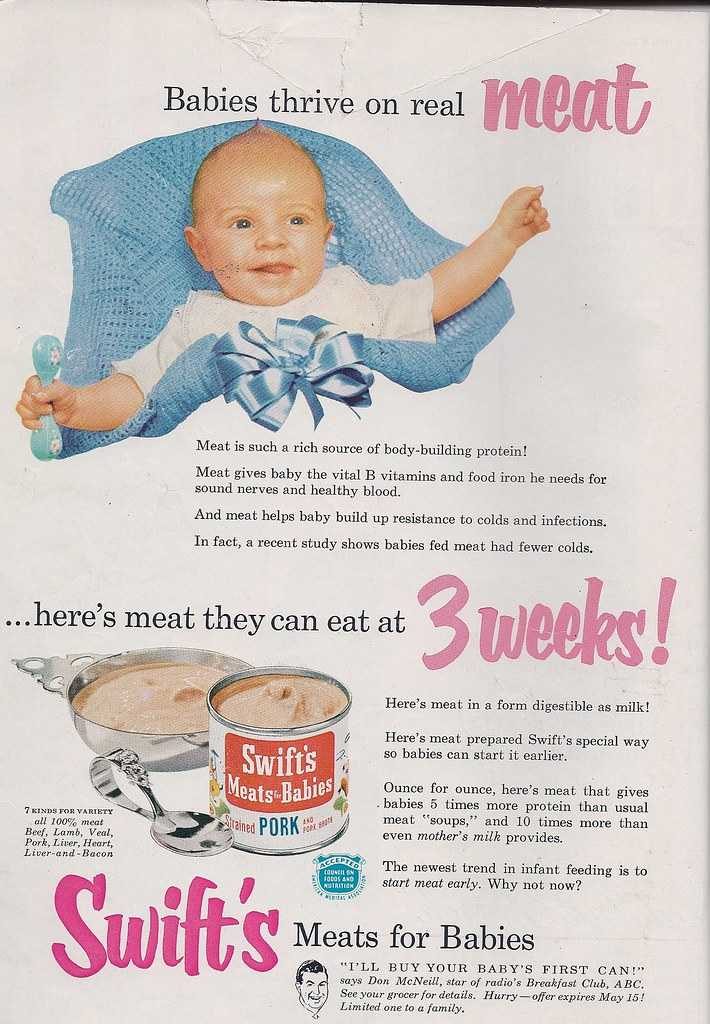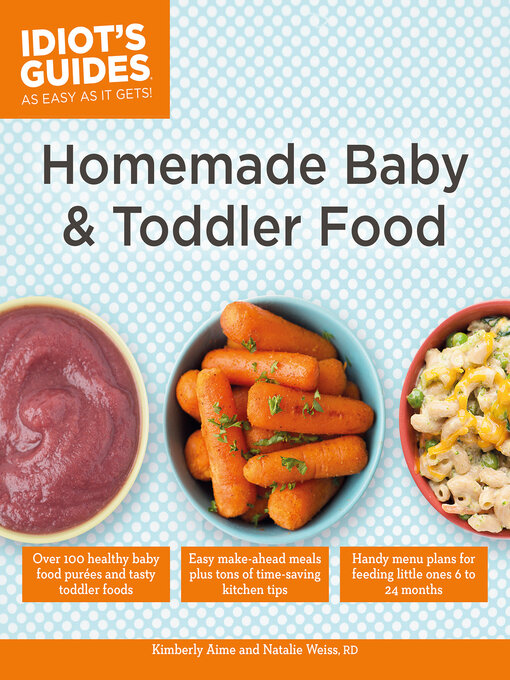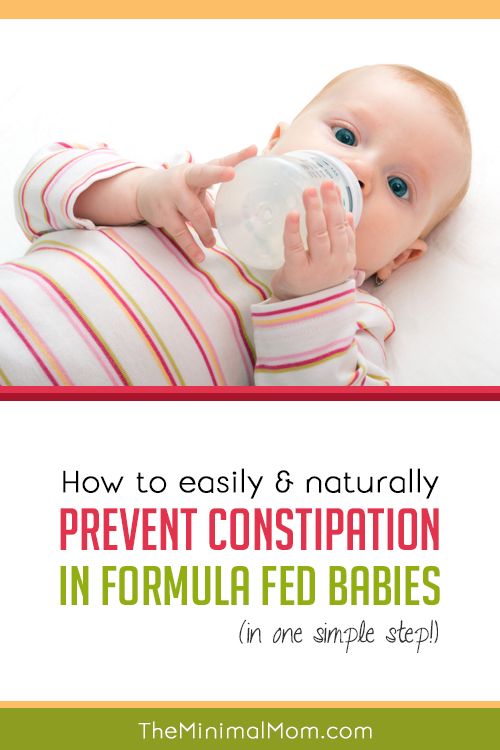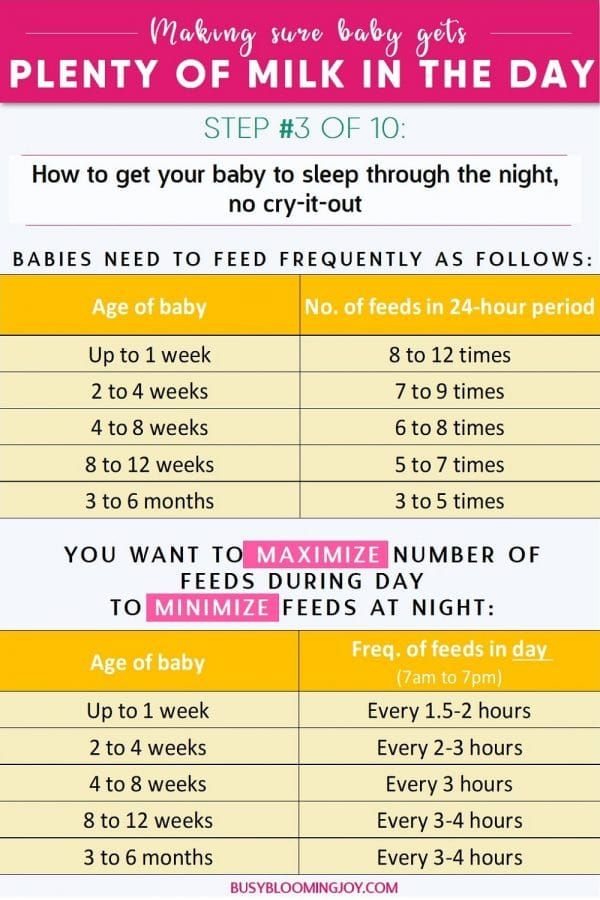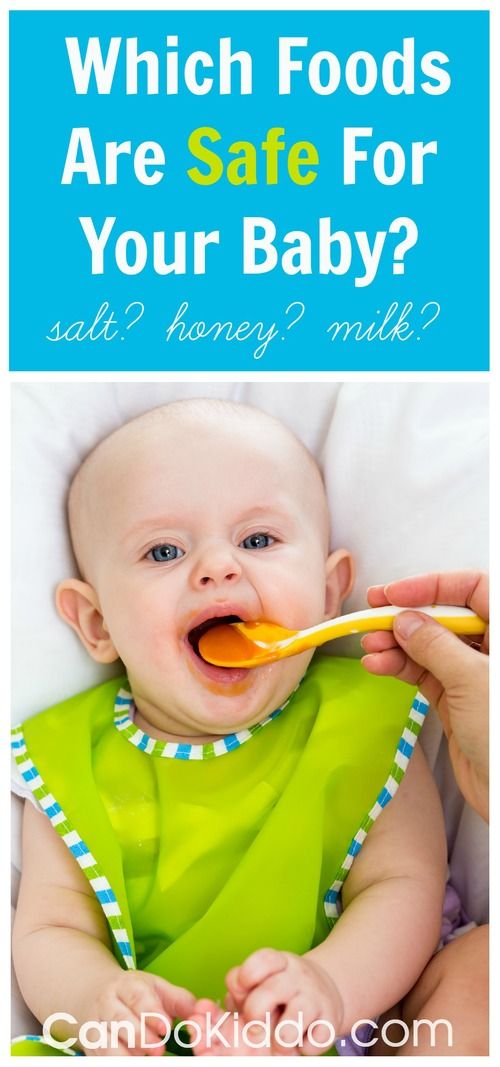Hand feeding baby canaries
Handfeeding Canaries, an unusual practice this day and age?
Vol. 24 No. 6 (1997), Articles
Vol. 24 No. 6 (1997)
Articles
- Sabra Dulkin
Sabra Dulkin
Why in the world would anyone want to hand feed Canaries in this day and age? All of our lives are so busy. I have two children that are very active and need my attention most of the time. They are in after-school activities that keep them busy which also keeps me busy since I am the designated driver!. I also help my husband run his business and I have a desktop publishing business of my own. We have a dog and I breed Fife, Lizard, Northern Dutch Frill and Hartz Canaries. Yes, I have to "come out of the aviary" so to speak. I do handfeed my Canary babies for the first week of their lives. Let me give you a few reasons why I engage in this practice followed only, usually, by the "big bird" people who are interested in selling "hand fed and tamed" birds.
My first but not most important reason is that I feel the Canary chicks that I handfeed are getting a little extra start in life that they may or may not be able to get from their mother/father. I've come to learn that the chick who can open its mouth and stick its head up the farthest get the most food. In Darwin's opinion, that means survival of the fittest. I'm not breeding Canaries to fight Goliath or some such enemy.
My birds don't have to be unusually strong to live the life that they're going to live. They have to be healthy but we as breeders keep the individual types exactly to specifications. (A good Gibber would· get blown right off course by a stiff wind.) My birds have to look good and be good parents and show well and breed other birds that will do the same. Just because a bird can't hold its head up as high as its nestmates, in my opinion, is no reason for it to die. Many times that is exactly why a chick dies ... simply because it wasn't as insistent as its nestmates about being fed.
The second reason why I hand feed my Canaries is because I don't know how to stop and smell the roses.
Confused? My life is very hectic. I have no time to do what I have to do let alone anything extra. I've heard about "smelling the roses" all my life but I never learned how. I am pushed and driven to achieve. I have tried many times to deal with this issue but to no avail-until I decided to start hand feeding my Canaries.
I've heard about "smelling the roses" all my life but I never learned how. I am pushed and driven to achieve. I have tried many times to deal with this issue but to no avail-until I decided to start hand feeding my Canaries.
When I sit down in my birdroom and prepare what I need for feeding, take the nest and set it in my lap, I actually relax and, believe me, that's no small feat. I take a deep breath and for the next 10 to 30 minutes, I help Mother Nature and wonder at the miracle of it all.
I see the tiny little bodies of the Canary chicks and marvel that they can lift up their heads and open their mouths instantly after hatching. I've actually jumped the gun a few times and found a chick in the middle of hatching. I've even helped take off the shell once or twice. These are miracles and I have seen them!
Another reason to supplement feeding is to help the hen out. If the hen has a lot of babies, she can use the help, especially if the cock isn't in with her. It's exhausting work for a hen to feed five or six babies alone.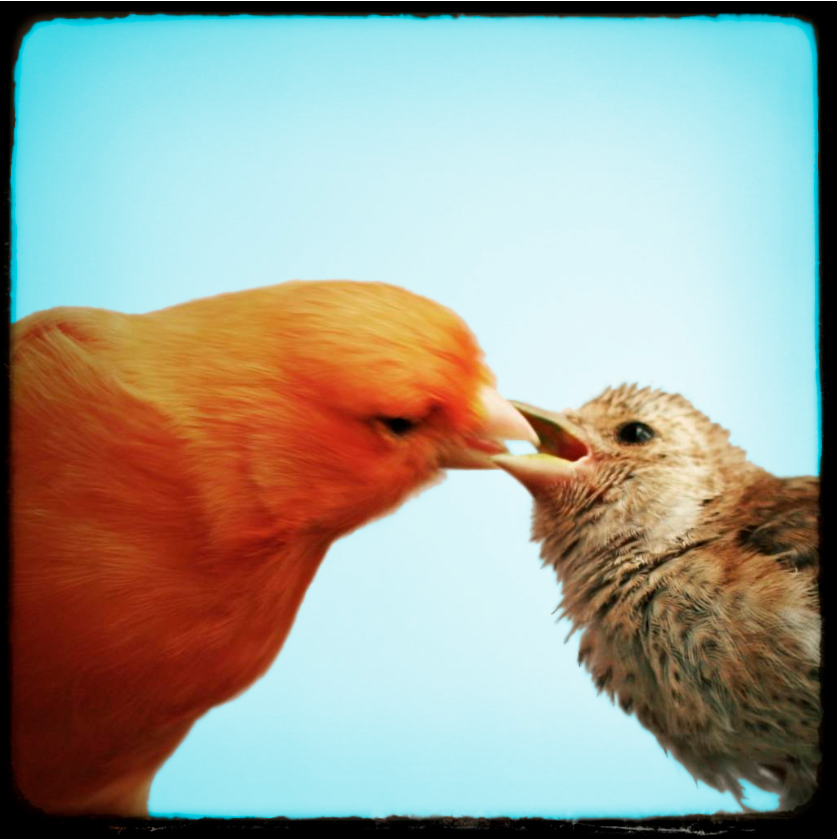 Also, sometimes a hen won't start feeding until all her eggs are hatched. If there is a little lag time there, the first baby can die while the other ones are waiting to hatch.
Also, sometimes a hen won't start feeding until all her eggs are hatched. If there is a little lag time there, the first baby can die while the other ones are waiting to hatch.
What is it that I hand feed my Canaries? I believe 100% in Abba Products. Abba is a company from Elizabeth, New Jersey that sells to bird breeders and stores. They will send you a price list if you request one. The man who owns the company is a real expert in the area of bird nutrition and health. He has formulated his seed mixtures after years of research. In my opinion, his quality can't be beat.
I use the Abba nestling food with seed (I think the number is 92A). I mix l 1/2 cups of Abba nesting food with one hard boiled egg chopped fine. I add
about 2-3 tablespoons of water to the mixture, just enough to get it moist but not wet. Then I take a small cap or container just big enough to hold about 2 tablespoons of Pedialyte (an oral electrolyte suspension that is given to children to replace electrolytes after very bad vomiting and/ or diarrhea). This is available in a generic solution also. I use the Arbor brand. I have a wooden match stick that I whittled down just a bit to fit into the little mouths but its not sharp or pointed. I simply dip the matchstick into the Pedialyte to wet it then dip the wet matchstick into the mixed nestling food and put a tiny bit into the chicks mouth. If it looks like a piece got in that is too big or not moist enough, I will give a drop of the Pedialyte plain-just enough to wash down the crumb. I don't fill up the birds until they're stuffed because I don't want the mother to get frustrated because her babies aren't interested in eating. I do this a few times a day for the first week.
This is available in a generic solution also. I use the Arbor brand. I have a wooden match stick that I whittled down just a bit to fit into the little mouths but its not sharp or pointed. I simply dip the matchstick into the Pedialyte to wet it then dip the wet matchstick into the mixed nestling food and put a tiny bit into the chicks mouth. If it looks like a piece got in that is too big or not moist enough, I will give a drop of the Pedialyte plain-just enough to wash down the crumb. I don't fill up the birds until they're stuffed because I don't want the mother to get frustrated because her babies aren't interested in eating. I do this a few times a day for the first week.
After the first week, the chicks can see much better and they're too scared to open their mouths. That's okay though because I have given them a great start. If they don't make it after I've been supplementing their feeding for a week then so be it. But I sure try not to lose them in the first week.
My system has worked out well for all concerned.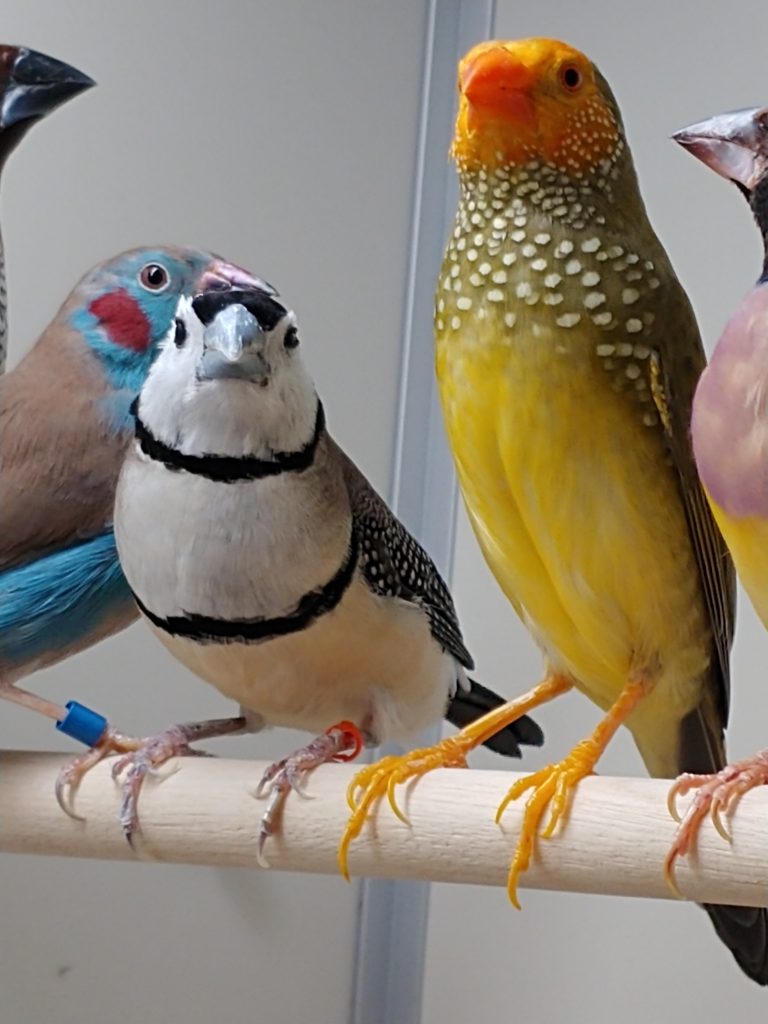 I have just banded my 40th baby bird and the breeding season is just half finished. Only one chick has been lost so far. I think I'm doing the best for the birds. I feel I'm giving the mother a helping hand. The babies are getting great nutrition. And last but not least, I'm relaxing!
I have just banded my 40th baby bird and the breeding season is just half finished. Only one chick has been lost so far. I think I'm doing the best for the birds. I feel I'm giving the mother a helping hand. The babies are getting great nutrition. And last but not least, I'm relaxing!
Everyone wins in this situation .
How to Hand Raise Baby Canaries
by Judith Willson / in Family
Hand-raising canaries is not something many people would choose to do. Hand-raising birds helps them bond with humans; however, hand-raising canaries is hard work and time consuming, and doesn't always have a happy ending. Birds this small need food every two hours when they are babies and are highly susceptible to infections. The good news is that you can hand raise canaries if something happens to the parent birds, and hand-raised canaries become tame.
- Hand-raising canaries is not something many people would choose to do.
- The good news is that you can hand raise canaries if something happens to the parent birds, and hand-raised canaries become tame.
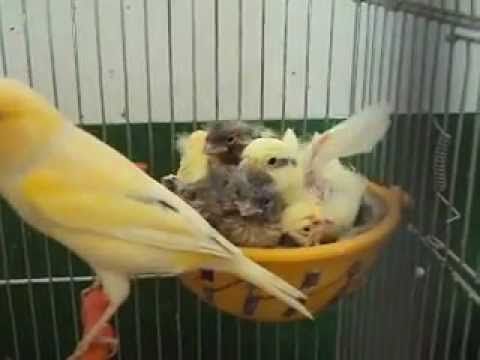
Set up a box or tank for the canary chick by putting the heatpad or hotwater bottle in the bottom and cover with a towel. To begin with, baby canaries need to be kept warm, at 32.2 to 37.2 degrees Celsius. Once the chick shows a good covering of feathers it will survive at room temperature. If using a hotwater bottle, replace the water inside regularly and check the temperature with a thermometer.
Make up formula in cup according to instructions and warm in a microwave or bowl of hot water.
Test the mixture on your own wrist to ensure it isn't too hot.
Give formula to the canary chick every couple of hours with a syringe. When it stops taking food or stops begging, it has had enough. Don't feed the chick more than it wants. Also look at its crop -- the pouch on its throat. It will be visible when full and should be nearly empty before the next feeding. You don't need to feed the chick from midnight to dawn.
- Make up formula in cup according to instructions and warm in a microwave or bowl of hot water.
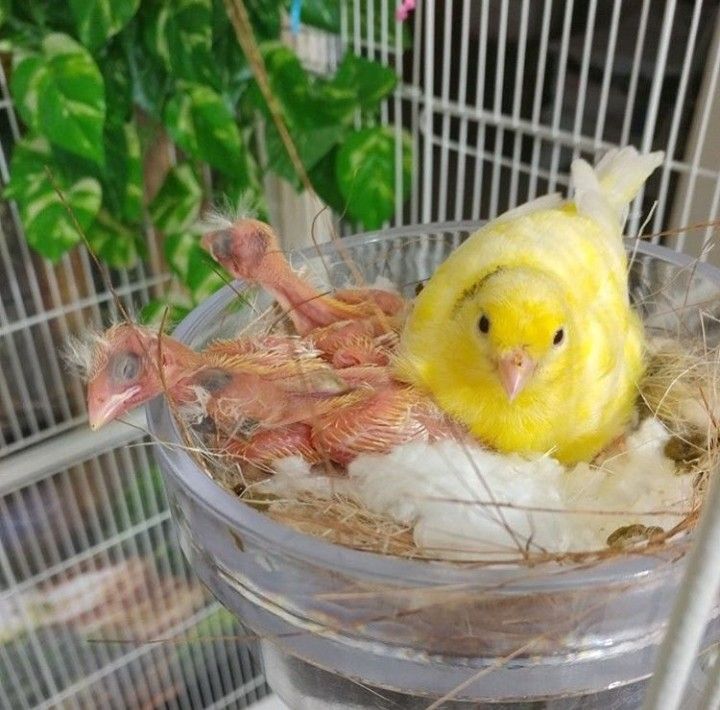
- You don't need to feed the chick from midnight to dawn.
Clean off excess formula from around the chick's face and beak with damp cotton wool.
Keep the canary chick and its box clean. Use a slightly damp face towel or more cotton wool to gently wipe the chick as necessary and wash the box towel every day. Replace the used towel with a clean one so you do not have to wait for the old one to dry.
- Clean off excess formula from around the chick's face and beak with damp cotton wool.
- Use a slightly damp face towel or more cotton wool to gently wipe the chick as necessary and wash the box towel every day.
Increase the time between feedings after a week or 10 days. Start feeding the chick once every 3 hours.
Wean the chick at three weeks old. The chick now has a good covering of feathers and will be exploring. Transfer to a birdcage if you haven't done so already and supply regular canary food. Continue the hand feeding for a further couple of weeks.
Choose a baby bird formula suitable for finches if you can't find one specifically for canaries. Canaries are a kind of finch. Hand-rearing small birds is difficult. Consult a vet who specialises in birds for expert advice and assistance.
Related
References
Author
- 1 Bird Health: Hand-rearing Birds
Care during molting. Canaries
Care during molting. canariesWikiReading
Canaries
Zhalpanova Liniza Zhuvanovna
Contents
Shedding care
During this period, birds need especially careful care, since molting itself, as already mentioned above, is a painful condition for canaries.
The molting period is the most important in a bird's life. With the wrong content of canaries at this time, they can lead to death.
This period usually falls in July, August and September. Particular attention should be paid to lighting and feeding canaries. The food should be rich and nutritious. When it comes to lighting, most birds need enough sunlight. To do this, pets must be placed in cages located on a balcony, terrace or just outside the window. However, you should not install them in the sun itself, otherwise the birds will simply die.
A characteristic sign of the beginning of the molting period is the cessation of singing. At this time, birds should be transplanted into a room in the fresh air. The most favorable place is a summer aviary.
Moulting canaries are fed with fresh herbs. Banks of water are placed in large cages or aviaries, in which fresh linden and birch branches are placed. In a separate feeder they give crushed shells, crushed coal along with ash, clay, lime, salt, as well as rotten hardwood trees.
Canary food should not be spared. No matter how abundantly they are fed during the molting period, they are not threatened by obesity. Especially a lot of soft food should be given. Shedding birds should not be handled or examined. At the slightest disturbance, birds can get scared and throw themselves on the grate, injuring the soft stumps of new large feathers. Such lesions bleed heavily, so the stump should be removed.
This text is an introductory fragment.
11. 2. Puppy feeding time
11. 2. Puppy feeding time The organism of a born puppy, getting into a new environment, will first of all try to adapt to food, to the very process of nutrition. In the subsequent period, changing different diets will also affect the behavior of the puppy:
Dog in heat
Dog in heat 360When a bitch is in heat (16, 368) you should take special care of her maintenance and cleanliness.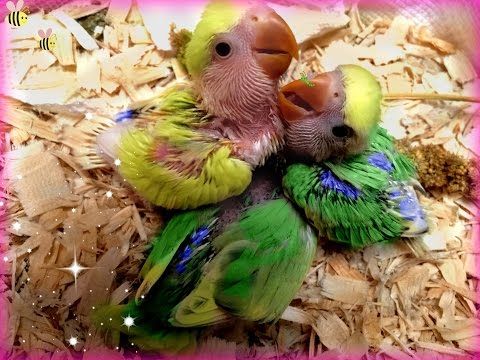 (338) she stays in her corner or in her booth, then your work is limited to regular cleaning of the bedding,
(338) she stays in her corner or in her booth, then your work is limited to regular cleaning of the bedding,
Optimum mating time
Optimal time for knitting The day of mating can be correctly calculated if you know exactly the start date of estrus. At this time, the female's external genital organ swells - a loop, it becomes larger and more noticeable than on other days. Sometimes during estrus, her milk may increase
5 Caring for a dog during pregnancy
5 Caring for a dog during pregnancy A pregnant dog requires special care. In order for the birth to go smoothly, without complications, and the puppies to be born strong and healthy, the dog owner must know the basic issues of veterinary medicine. A healthy dog has pregnancy
Care of the bitch during pregnancy
Bitch care during pregnancy As soon as you decide to get offspring from your dog, first of all, you should notice the first day of estrus. The first day is considered the day when you found the first, albeit pink, smear on the dog's bedding. For the dog to give birth, then
The first day is considered the day when you found the first, albeit pink, smear on the dog's bedding. For the dog to give birth, then
Complications during childbirth
Complications during childbirth In most hamsters, childbirth proceeds easily and smoothly, however, in some cases, complications can occur that threaten the life of the female and cubs. Therefore, it is important for every hamster breeder to be able not only to recognize birth complications, but also
"And you can't stop time for a moment..."
"And you can't stop time for a moment..." This is how Alla Pugacheva sang in the old song. Yes, it only happens when time stops, and this is by no means an artistic metaphor. And this happens in such moments of life that you don’t want to relive at all. For the first time, I visited
Lunch time
Lunch time A dog with a dominance problem should never be allowed in the kitchen or dining room while the family is having dinner.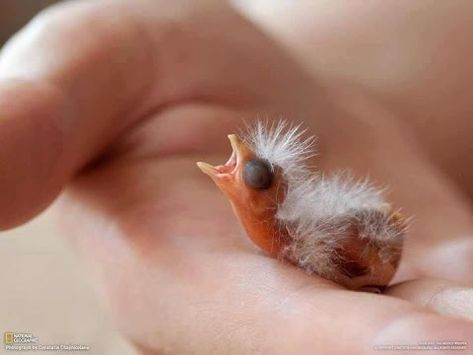 The worst thing you can do is feed a dominant dog off the table. Also, the leader of the pack always eats first
The worst thing you can do is feed a dominant dog off the table. Also, the leader of the pack always eats first
Wrong mating time
Wrong knitting time This cause of infertility is the most common. Fertilization will not occur if the bitch is mated before or after the release of mature eggs. In fact, this is not infertility, the animals are actually healthy, you just need to do it right
Time of stress
Time of stress In dogs with healthy heredity, whose ancestors, however, did not undergo rigorous selection for resistance to stressful influences, it is possible to induce panic behavior in response to a loud sound only after combination with a very strong influence
Complications during childbirth
Complications during childbirth In most decorative mice, childbirth proceeds easily and smoothly, however, in some cases, complications can occur that threaten the life of the female and cubs. Therefore, it is important for every rodent breeder to be able not only to recognize generic
Therefore, it is important for every rodent breeder to be able not only to recognize generic
Feeding during moulting season
Feeding during shedding season During the most intense molting, pigeons should be fed as plentifully as during egg laying, because the pigeon's body requires additional nutrients to form a feather cover. During this period their food is
Feeding rules and times
Feeding rules and times If the dovecote contains pigeons of different breeds (large and small), it is recommended to feed them separately. Large birds with large long beaks eat food faster, which can leave short-billed pigeons hungry. Also, for birds
Special care during moulting
Features of care during molting Periodically, chickens molt - the replacement of old feathers with new ones. The replacement mechanism is due to the expulsion of old, dying feathers, new, growing ones. There are two types of molting - juvenile and
The replacement mechanism is due to the expulsion of old, dying feathers, new, growing ones. There are two types of molting - juvenile and
What to feed a canary|Food for a canary
Proper canary diet plays a very important role in the life of your feathered pet. Proper nutrition for birds is especially important during the breeding and rearing of chicks. What to feed the canary ? Let's figure it out together.
Unfortunately, today it is not uncommon for the owner, when purchasing a pichuga, not to know the basic rules for feeding canaries. Meanwhile, the composition of the feed is not only responsible for the health of the bird, but also affects its mood. If your canary does not sing, there is reason to wonder if you are feeding it correctly?
Canary grain food
Canaries, like many other birds, mainly eat grain food. It is best to choose a balanced grain composition for your pet. Such kits can now be easily found in any pet store.
It is best to choose a balanced grain composition for your pet. Such kits can now be easily found in any pet store.
Which canary food to choose from the variety of the presented assortment? Rely on common sense. Feeds are similar in composition, but imported analogues, as a rule, are much more expensive, and the shelf life is shorter, since a lot of time is spent on their delivery from abroad.
"Native feed" for the most relatives
Among the feeds of Russian manufacturers, "Native feed" compares favorably. Made on the territory of the Russian Federation from domestic products, they fully meet quality standards and are more than affordable. The composition of feed for canaries "Native feed" includes: rapeseed, yellow and red millet, canary and hemp seeds, flax, white sorghum, carrots.
Nutritious and delicious food contains all the nutrients your feathered pet needs.
Vegetable foods can be divided into three groups: oilseeds, grains and succulents. Cereals, as already noted, are the main ones in the diet of birds. Other types of feed are added periodically and in small quantities.
Cereals, as already noted, are the main ones in the diet of birds. Other types of feed are added periodically and in small quantities.
You can offer your bird raw buckwheat seeds, rice, corn, weed seeds, bran. The last canaries are not very fond of. However, it is a healthy food for the bird. Mix bran with wet food (egg and carrots, for example).
Canary seeds and nuts
Nuts are canaries' favorite food. They are rich in fats, so you need to be very careful when offering this food to your bird.
Sunflower seeds contain up to 45% oil. Make sure that their share in the daily diet of the bird does not exceed 5-7%. Peel the seeds from the husk and crush before offering to the pet. It is best to combine the seeds with grated carrots and crushed wheat croutons.
Vegetables, fruits and berries for canaries
Of course, a complete diet for poultry should include vegetables, berries, and herbs. These products saturate the canary with vitamins and are also a source of useful minerals. Such feed is called juicy.
Such feed is called juicy.
Canaries love sweet apples, apricots, cherries, peaches and grapes. Offer treats in small bites, fastened between the bars of the cage or placed directly in the feeder.
Add freshly squeezed juices to your bird's diet, especially in winter when vitamin deficiencies are most acute. If squeezing juices on your own is problematic, you can use juices produced for baby food.
Fresh twigs for canaries
In winter, put twigs from fruit and deciduous trees into the canary's cage. Birds peck them with pleasure, getting fiber and additional trace elements, as well as vitamins and salts. Canaries often gnaw the twigs clean. It is best to use branches of apple, cherry, raspberry, currant, alder, mountain ash, elderberry, maple, linden, birch, viburnum, aspen, beech.
We will continue the topic of feeding the canary in our next article, where we will discuss in detail animal foods, the necessary vitamins for the canary, and what not to feed your bird.


